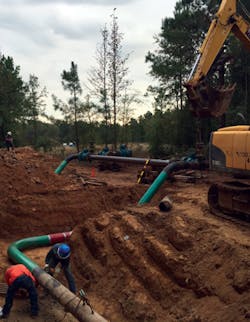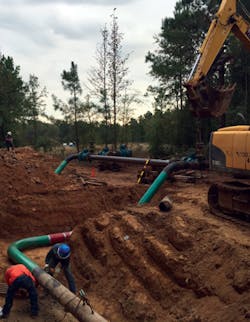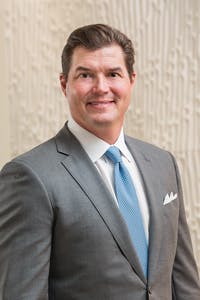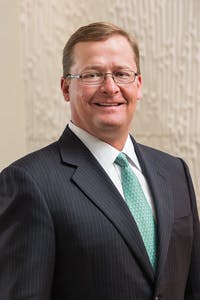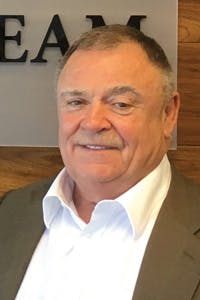PRIVATE EQUTY FIRM INVESTS IN MIDSTREAM AND IN NON-OPERATED WORKING INTEREST UPSTREAM ASSETS
EXECUTIVE PHOTOS BY BRANDON PARSCALE
EDITOR'S NOTE: We recently spoke with Tailwater Capital's co-founders, Jason Downie and Edward Herring, about their thoughts on the role of private capital in the current low-price environment. The firm is based in Dallas. Fritz Brinkman, president and CEO of Align Midstream Partners, also participated in the interview. Align is a Tailwater portfolio company.
OIL & GAS FINANCIAL JOURNAL: Tailwater Capital is a private equity firm totally dedicated to the energy industry. Your investments are predominately focused on midstream companies and upstream projects. Can you tell us about the firm and how you started?
JASON DOWNIE: Tailwater invests exclusively in energy and has $1.7 billion of private capital in four funds. Two of the four funds are focused on midstream control equity, and the other two funds are focused on non-operated working interest upstream investments. Edward and I co-founded Tailwater in January 2013 after working at a large generalist private equity firm where we focused on energy investments. We've actually worked together for more than 18 years - the last 13 of which have been exclusively in energy.
OGFJ: So what's your ultimate strategy and where are you seeing opportunity in today's market?
DOWNIE: Over time, our investment strategy has evolved. Because of the opportunity we saw in the market, we moved from a singular philosophy of backing management teams with control equity in the midstream and upstream industries, to adding an additional investment alternative of purchasing non-operated upstream investments.
EDWARD HERRING: Our midstream strategy is pretty straightforward. It involves backing teams to de-bottleneck areas by providing growth capital for solutions-oriented midstream developments. Transactionally, it can take many forms. But generally it's always control private equity, and it's been that way since we started. We target basins where the geologic opportunity makes sense economically and where we can underwrite a deliverable value-add proposition.
The upstream space is a little different. While we have historically done traditional control private equity in E&P, today we prefer non-operated working interest opportunities. Because of the numerous delineated infill locations in North America, we can design interesting vehicles and cherry-pick the best areas behind the best operators. We get the added benefit of exposure and ownership in different wellbores across multiple basins. Our first non-operated E&P fund raised $120 million, and we have more than 200 wells that we are partnering in. So we have a lot of asset-level exposure and information per dollar invested. And in February of this year, we closed on our second E&P fund for $218 million, which will have the same investment methodology. This two-prong strategy, midstream and upstream, can be used as offensive weapons for us. As a middle market private equity firm, we feel these complementary strategies provide us a strong and sustainable competitive advantage.
OGFJ: What opportunity did you see in the non-op E&P market that pushed you to expand outside of your midstream control equity focus?
HERRING: When Jason and I were at our prior firm in 2003, we watched as activity in conventional plays was replaced by activity in unconventional plays like the Barnett, Haynesville, Eagle Ford, Niobrara, and Bakken. Numerous private equity companies started deploying large amounts of capital to delineate these plays and build value through large-scale manufacturing operations. We started Tailwater in 2013 and felt the delineation phase of the upstream space was well underway and that a new opportunity had emerged to invest in non-operated development of infill projects in core areas of these delineated plays. Companies that had working interests in these areas now needed vast amounts of capital to participate because of how many infill locations were being developed. We wanted to be that source of capital.
OGFJ: Do you have a certain commodity focus - oil, natural gas, or natural gas liquids?
DOWNIE: No, we are more returns driven. We look at producer economics and focus on type-well profiles. We have exposure to crude oil and gas. Across the midstream platform, we like rich gas the most because it provides the most opportunities for fee-oriented services. You can charge a fee along the entire value chain from gathering, compression, to treating, processing, and fractionation. That being said, we want our teams to take a solutions-oriented approach to the market - solving problems for our producer customers, which means we will look at gas, NGL, condensate, oil, water, or solids.
OGFJ: As investors, what do you offer management teams and investors that other private equity firms do not? Said another way, what's your core differentiator?
DOWNIE: First and foremost, we like being smaller than our mega-private equity peers because we never want to say "no" to an economic deal just based on a commitment size. If you are in the right basin, generate good economic returns, and have an interesting value proposition, we want to look at it. We often find that if one producer has a problem that's not being met by a large MLP or a service provider then many other producers are probably having the same problem. So a small midstream project can become a large business if you are creative and solutions oriented.
Also, we have, by design, a higher concentration limit, meaning, we don't need six teams on six projects. We can have one team on six projects based on their historical experience. This is how we can compete. Our teams can be collaborative and not feel like they are competing with Tailwater's other teams and that's a lot different than other shops.
One other thing I'd add is that we have very supportive limited partners, so even though we are concentrating on smaller deals in the middle market, we have the ability to scale up. One of our midstream funds has $650 million, and we have supportive investors so we can be opportunistic on larger deals as well.
HERRING: When you focus on the middle market in the midstream space and can commit to investments less than $100 million, your ability to transact goes up dramatically because the number of counterparty agreements is small, as compared to a 600-mile pipeline that requires agreements from 30 companies. Our aspiration is not to be excellent asset managers, we want to be excellent partners and back entrepreneurs that want to create value and can de-bottleneck constrained midstream markets.
OGFJ: What is the typical investment period for Tailwater before you monetize it?
HERRING: Our typical hold period ranges from three to six years, depending on the deal. Our main focus is generating a return on capital deployed. There are two styles of investments for us. The first is an anchored greenfield project. The other option is to buy a strategic set of assets that is already cash-flowing that you hope to grow. The anchored greenfield project usually takes more time. They were attractive between 2009 and 2014. There is a tremendous amount of front-end planning and underwriting to figure out what the ultimate value-add will be. Then you work to develop the assets over 18 months and need to get the set of assets to cash-flow maturity.
OGFJ: You talk about alignment of interest and long-term partnership approach as two of the key components to creating a strong foundation for a successful investment. When you are making investments, what are you looking for in management teams or assets that give you confidence that they are the right team or asset to back?
DOWNIE: We look for teams with distinct core competencies and distinct knowledge of particular basins. These are the teams that know the producers, land owners, geology, existing pipe, and bottlenecks. You can't teach that kind of knowledge. Beyond that, we are looking for teams that like the collaboration of a partnership model. We view trust, transparency, and teamwork as core to all of our deals. Good management teams translate to good investments. We want people who have balanced approaches and balanced mindsets. Our teams understand organic growth capital and acquisition capital. They understand how to manage a balance sheet relative to certain times of the commodity cycle. They have a methodical thought process and track records of execution. You put all that together and that's a win-win for Tailwater and our teams.
OGFJ: If a management team looking for capital has filed for Chapter 11 bankruptcy or had financial woes in their past, does this affect their chances for partnering with Tailwater?
HERRING: There are not many seasoned teams or people in this business that have not been through a cycle or experienced hard times. Jason and I experienced 1998-1999, the massive spike in energy prices from 2002-2005, the crisis in 2008, and today's collapse. Cyclicality takes its toll on a balance sheet. We can't always hold that against individuals. Every case is different, so we look at every one on a case-by-case basis. Integrity is important to us, and we want to partner with honest teams. Bankruptcy does not preclude us from partnering with someone - we do our due diligence and make our decisions accordingly.
OGFJ: So you are looking to see how much of the downfall or performance was related to team decisions versus the cyclicality of the industry?
HERRING: That's right. We are extremely exhaustive to sort through what is accountable to the people versus what's accountable to the macro. We try to get a firm understanding of what's driving success or difficulties with our backed teams to see if it's macro or strategic decision they are making. When we only look to back six to nine teams per fund, every management team plays a key role in the long-term success of our organization.
OGFJ: Do you believe the cycle has pretty well bottomed and are you looking at new investments?
DOWNIE: We believe time is right but it's very situational. We closed our most recent midstream fund in December 2014. We've been very patient and only deployed 20% of that fund, so we have a lot of dry powder remaining in 2016. Four years from now, we believe 2016 will have been a great year to put assets on the books. It is still all about focusing on the core competencies - that's solutions oriented, win-win solutions. The macro turn we've seen caused us to pivot from what would have been a lot of greenfield projects and new construction, to buying assets. We've been successful because the MLPs that we were competing with previously that had extremely low costs of capital now have high costs of capital and are struggling to acquire cash-flowing assets.
HERRING: The nature of what owned assets are deemed to be "core" by E&P companies has changed significantly in the last 18 months. In 2014, core assets included midstream assets like gathering systems and ownership in processing plants. Now, with significant capital challenges driven by commodity price declines, E&Ps define core assets as tier-one acreage, and everything else, including midstream, is being looked at as non-core and is available to be partnered with to free-up capital. In turn, they can then deploy that capital to drill their best acreage. It took a low commodity environment to make that happen.
OGFJ: You closed Tailwater Energy Fund II back in December 2014. Shortly after, you funded Align Midstream Partners. How does Align complement your firm's strategy for value creation?
HERRING: Align's strategy in East Texas is to find unique non-core packages where we can acquire assets in the ground and optimize them. We are looking for pipes and plants that are non-core and haven't been fully utilized in years. It worked when we partnered with Fritz Brinkman, the current CEO of Align, to build Regency Energy Partners and take it public. We wanted to pursue that strategy again. We're leveraging his four decades of experience to identify non-core midstream assets, purchase them at a good price, and generate value.
OGFJ: Fritz, you are the CEO at Align. The private equity space is competitive. What were you looking for from a capital provider and how did you decide to ultimately work with Tailwater?
FRITZ BRINKMAN: I've been in the oil and gas business for more than 47 years and have been involved in everything from operations, to gas supply, marketing, and greenfield M&A. Other than the strategy, which I liked, I worked with Jason and Edward when we acquired Regency. To me, Jason, Edward, and all of Tailwater have the highest integrity - I trust them 100%.
The other part was communication. I like creativity, and Jason and Edward never stopped me when I presented a unique, creative idea. We would sit down and go through it and walk through the idea. You can't beat that. You need the key component of teamwork. One of the other things is Tailwater's commitment to a team's success. We had to change directions on a project and received the news at 4 pm on a Saturday. We called Tailwater and they helped us work through the financial structuring over the weekend. On Monday, we were able to resubmit our proposal and continue negotiating on the deal.
OGFJ: Tell us more about "Debottlenecking" - it's a key part of your strategy. Are there still debottlenecking problems even in this market? How else are you creating value?
BRINKMAN: I was fortunate to work with an interstate pipeline company, the first one to move into the Gulf of Mexico. We moved gas through an extensive network of pipelines to get gas back to the original system. Then, I worked with another interstate pipeline company on a whole different part of the United States, so I've learned a lot about numerous pipeline networks and how to get gas around the US. And back then we didn't have computers, so we learned a lot about where physical assets were because we were hands-on.
We prefer to evaluate an area, understand the pipe and how much gas is coming in. Then we can put together a formal plan to execute on and create value. One example was our recent SONAT deal announced back in April 2015. SONAT was the first asset we acquired after our funding from Tailwater. A large MLP was not using the main transportation pipe on the last 34 miles that runs from Carthage (Texas) down to Logansport in north Louisiana. Since they weren't using it, there were no customers. So we ended up buying it, turning it into a gathering system, and then repurposed the pipeline to transport rich natural gas for liquids processing. That pipe now serves as the trunk line to help producers in the area transport gas to Carthage. So we basically spun an interstate pipeline into an intrastate pipeline, reversed the flow, and told producers we can give them a new pipeline that doesn't have 7% line loss. But to do all that we want to buy your gathering system and get a long-term contract from you, that way the operator could take that capital and put it into the drill bit. So we created a win-win. It was creative. So now this is the anchor for us to find more producer-oriented assets that we can create win-win opportunities.
HERRING: This goes back to our early point about how small deals can turn into big deals if you're willing to invest the time and capital. We have the asset now and we can see the upside potential and ancillary opportunity to connect gas flow to the line. Not only that, they had 25 compressors on that pipeline. We're down to 10 because we're still optimizing. We'll continue upgrading and expanding this area.
OGFJ: It's a tough market out there. What will 2016 look like for Align? Are you actively looking for acquisitions or will you look to grow organically this year?
BRINKMAN: We'll see growth in 2016. We are looking at several different assets that we want to rationalize, repurpose, and tie in to existing footprints. There's opportunity in East Texas, in our back yard, and we'll continue to develop relationships with producers. We're cutting operating costs and volume costs, so we may look at other basins and regional expansions. We believe the Delaware Basin (in West Texas) could hold some attractive assets that fit our model.
OGFJ: Anything else you'd like to add?
HERRING: We think 2016 will be an exciting and active year for us. We like fair deals for both parties. We're seeing more of those at these levels, definitely different than early 2015. When oil hit $26, we found the market had become much more target rich. We have teams mobilizing, and we're very enthusiastic about what the future holds for Tailwater, our investors, and our portfolio companies.
OGFJ: Thank you all for your time.
